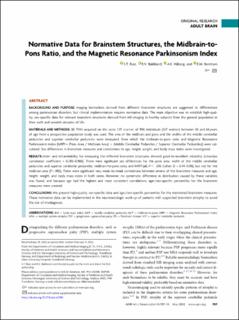| dc.description.abstract | BACKGROUND AND PURPOSE: Imaging biomarkers derived from different brainstem structures are suggested to differentiate among parkinsonian disorders, but clinical implementation requires normative data. The main objective was to establish high-quality, sex-specific data for relevant brainstem structures derived from MR imaging in healthy subjects from the general population in their sixth and seventh decades of life.
MATERIALS AND METHODS: 3D T1WI acquired on the same 1.5T scanner of 996 individuals (527 women) between 50 and 66 years of age from a prospective population study was used. The area of the midbrain and pons and the widths of the middle cerebellar peduncles and superior cerebellar peduncles were measured, from which the midbrain-to-pons ratio and Magnetic Resonance Parkinsonism Index [MRPI = (Pons Area / Midbrain Area) × (Middle Cerebellar Peduncles / Superior Cerebellar Peduncles)] were calculated. Sex differences in brainstem measures and correlations to age, height, weight, and body mass index were investigated.
RESULTS: Inter- and intrareliability for measuring the different brainstem structures showed good-to-excellent reliability (intraclass correlation coefficient = 0.785–0.988). There were significant sex differences for the pons area, width of the middle cerebellar peduncles and superior cerebellar peduncles, midbrain-to-pons ratio, and MRPI (all, P < .001; Cohen D = 0.44–0.98), but not for the midbrain area (P = .985). There were significant very weak–to-weak correlations between several of the brainstem measures and age, height, weight, and body mass index in both sexes. However, no systematic difference in distribution caused by these variables was found, and because age had the highest and most consistent correlations, age-/sex-specific percentiles for the brainstem measures were created.
CONCLUSIONS: We present high-quality, sex-specific data and age-/sex-specific percentiles for the mentioned brainstem measures. These normative data can be implemented in the neuroradiologic work-up of patients with suspected brainstem atrophy to avoid the risk of misdiagnosis. | en_US |
